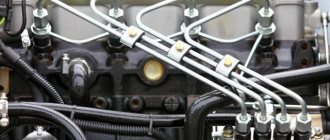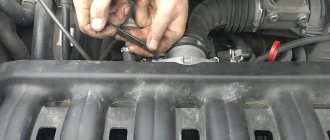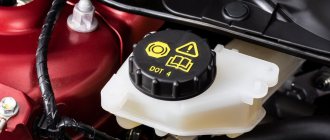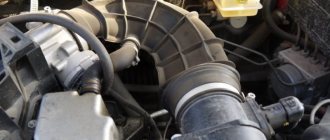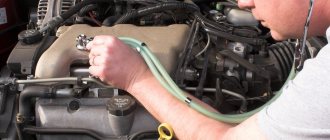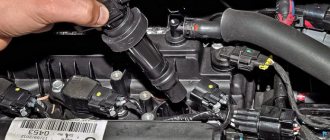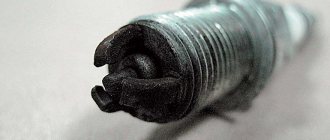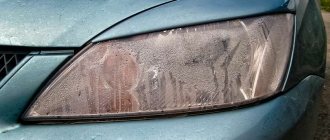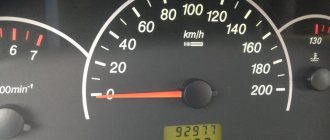Every year the share of cars with diesel engines is increasing. And if previously such engines were associated with commercial vehicles, now tractor engines can often be seen on small cars. Such a high popularity of diesel cars is due to low fuel consumption and high torque. Due to the turbine, the power of such cars is no less than that of gasoline cars, and the consumption is one and a half to two times lower. But you need to understand that diesel is a completely different philosophy. These internal combustion engines have their own differences and repair features. In today's article we will look at a fairly common problem - air leaks in the diesel fuel system.
Symptoms
Usually, in this situation, the engine starts well when cold, but further operation at idle raises questions. Among the characteristic symptoms are:
- Shaking and tripping of the power unit.
- Slow response to the gas pedal.
If the problem continues to be ignored, a long and difficult start-up of the internal combustion engine may occur. Sometimes the situation reaches the point where starting the car becomes completely impossible. There is too much oxygen in the system for the mixture to ignite properly.
The last step to remove air from the diesel engine is to bleed the system
If the fuel injection pump is in order and it was possible to eliminate all air leaks in the fuel system, you need to bleed it.
Bleeding the system
Pumping the filter:
- Loosen the screw on the housing.
- Bleed the system with a pump. It is necessary to ensure free flow of fuel without bubbles.
If there is no pump, you can pump the filter with a starter. It is also better to perform pumping with the starter connected, so as not to drain the battery.
Bleeding the injection pump:
- Loosen the center bolt.
- Turn on the ignition.
- Bleed the system with a hand pump.
- When most of the air has escaped, tighten the bolt, but leave it loose to control the escape of any remaining air.
If the diesel does not come out of the fuel injection pump, you can pump the system a little with the starter
- When the air bubbles have disappeared, you need to unscrew the bolt again and turn the starter, the fuel should flow in a dosed manner with a pulsation.
Have you achieved this result? Tighten the bolt.
Bleeding fuel lines:
Open the fuel line fittings one by one and turn the starter. It’s more convenient to do this with an assistant, the assistant turns it, you watch the fuel.
The procedure for removing air leaks and bleeding the system is complex. It requires professional participation. There are risks of incorrect assembly of the system and damage to other units (in particular, the starter). It is better to entrust this procedure to professionals. This way, you are guaranteed to receive qualified assistance and drive away in a working vehicle. Need help with diesel? Contact CarCity. Consult and sign up for service by calling 8 029 359-27-14. If I can’t find the car, call our tow truck 8 029 685-19-00.
Source
Causes of suction
There are many reasons for this problem. This:
- Rotten clamps and dried out fuel hoses. This is the most popular reason why air appears in the return line of the diesel fuel system. This problem is especially relevant for car owners with plastic hoses. Unlike brass ones, they have quick releases. Of course, replacing such a hose is much easier. However, it is the quick releases that turn out to be the most fragile in this element. As a result of vibrations, the plastic wears out and the rubber sealing rings wear out. Often a similar problem can be found on cars with a mileage of 200 thousand kilometers.
- Rusty tubes, especially at the entrance to the gas tank. The problem is relevant for cars with high mileage or for cars that have not been used for a long time (more than six months).
- Poor filter or booster pump seal.
- Violation of the tightness of the return line and the fuel injection pump drive shaft.
- Damage to the pump cover and the axis of the diesel supply control lever.
It is possible that air in the fuel system of a diesel engine (Volkswagen or another brand of car) enters through the fuel injection pump itself. However, it is better to entrust all diagnostic operations and repairs of this pump to professionals, otherwise there is a risk of incorrectly assembling the mechanism. Among the common causes of air leaks into the fuel system of a diesel engine is a poor-quality filter or its loose fit to the surface. This is the most banal option.
Note that air leaks into the fuel system of a diesel engine appear when both the direct and return branches are damaged. Due to the design features of the injection pump or engine, some of the fuel may remain in the pump, which ensures good starting. However, with further work, characteristic problems appear. The engine does not have enough fuel, and it begins to “suffocate” without it.
Air leak points
The main places through which suction can occur include:
- intake manifold gasket;
- throttle body gasket;
- section of the pipe from the air filter to the throttle assembly;
- injector O-rings;
- vacuum brake booster;
- vacuum hoses;
- adsorber valve;
- idle air control (if equipped).
Separately, it is worth considering the places where air is sucked in on carburetor engines - there are no electronics there, and air can only be sucked in at the vacuum booster or somewhere in the carburetor.
Choke points (carburetor)
- The screw has the quality of the fuel mixture.
- For the gasket under the carburetor - areas with soot are a sure sign.
- Through a loose throttle valve.
- Through the throttle axes.
- Violation of the integrity of the throttle damper, economizer or starting diaphragms.
How to check?
To make sure that the cause of unstable engine operation is air leaks, you need to visually analyze the flow of fuel into the cylinders. To do this, turn the engine with the starter for about 20-30 seconds. So we will fill the exhaust tract with gases, after which we will analyze them. If there is something wrong with the fuel system, a small amount of smoke (usually gray in color) will come out of the pipe. If the exhaust has a bluish-gray tint, it means that a large volume of oil is entering the combustion chamber.
Emission testing
Exhaust check
A method invented a long time ago. It is used by most experienced diesel drivers. The essence of the method comes down to the following.
- The engine is cranked by the starter for one minute, but does not start.
- The muffler is checked at the same time.
If smoke comes out of it, then this indicates fuel is entering the cylinders, since there is no such thing as combustible smoke. If there is diesel fuel, it means there is no air in the system.
The smoke may have a grayish tint, there may be little or much of it, but this does not change the essence. On the other hand, it rarely happens that fuel does not enter the cylinders, but smoke continues to flow. In this case, you need to pay attention to the color of the smoke. If it is blue, this indicates that oil has entered the internal combustion engine cylinders.
Thus, exhaust testing boils down to the following: there is smoke, good, there is no air lock, there is no smoke - definitely, there is air in the system.
Professional diagnostic methods
The classic way to check the tightness of this system is with compressed air. To do this you will need a small amount of fuel and chalk. The last thing you need to do is rub the tubes and hoses through which the fuel moves. Next, remove the fuel intake from the tank and remove the coarse filter. Compressed air is supplied to the fuel intake at a pressure of no more than 0.5 kgf/cm2. At home, this pressure can be taken from a regular tire tube or wheel. Next, all tubes and hoses are inspected. Particular attention is paid to connection points. As practice shows, in 80 percent of cases the reason lies here. In such areas, the chalk will darken as the fuel flows out.
Please note that damage may also be of a “valve” nature. That is, air can only enter the system in one direction.
Let's consider another method. To accurately diagnose the air in the diesel fuel system, it is necessary to disconnect the injection pump from the lines and power it from another container with fuel. Usually a three-liter bottle and two meter-long durite hoses are taken. To prevent them from coming off, you also need clamps of appropriate sizes.
Diesel engines
In a diesel engine, diesel fuel enters the cylinders bypassing two fuel subsystems - low and high pressure. As a rule, it is in the low pressure area that air leaks occur.
This can happen through many pipeline joints, connections of fuel system elements, including the fuel injection pump.
The problem is aggravated by another point. To reduce the cost of producing diesel cars on modern models, instead of traditional brass tubes, plastic products are used, which wear out much faster.
Aggressive environment, vibrations, temperature changes - all this negatively affects their performance. This also applies to seals. As a rule, all this begins to manifest itself after 120-150 thousand km. mileage
Often, obvious leakage of diesel fuel when the engine is not running can indicate a problem area.
But when the car is running, when fuel is pumped from the tank, a pressure is created in the system that is lower than atmospheric pressure and therefore it is problematic to immediately identify air leaks.
Signs
The bottom line is that the mixture of diesel fuel and air entering the fuel injection pump when starting the engine does not allow it to perform its functions 100%, i.e. overloads it with a large amount of air in the fuel chamber.
When the car is already running, fuel enriched with air foams heavily and increases in volume. Therefore, at high speeds, the fuel injection pump does not have time to pass it through itself.
As a result, when you try to start a diesel car in the morning, you have to oil the starter for a long time, and you will see a little smoke from the exhaust pipe. And when driving or standing at traffic lights, the engine may stall due to insufficient diesel fuel entering the cylinders.
Causes
Causes of air leaks in diesel cars:
- Wear of rubber seals including fuel filters;
- Loosening clamps;
- Damage to the fuel tank;
- Wear and cracking of hoses;
- Damage in the return line;
- Wear of seals in the fuel injection pump cover, drive shaft, fuel supply lever axis.
Looking for problem areas
The easiest and most effective way to find places where air is leaking is to apply pressure to the tank. Leaking diesel fuel and hissing air will indicate problem areas.
A more complex, but clear way is to replace standard pipelines with transparent ones. You will clearly see where it is leaking.
The exclusion method is often practiced, when instead of a tank in certain areas a canister of diesel fuel is connected to the fuel system.
You need to start with the injection pump and if the engine starts without problems, then move further to the tank along other elements of the fuel system.
This way you will eliminate the problem area and quickly find the place where the air is leaking.
What's next?
So, we disconnect the hoses from the pump and install recently purchased ones in their place. We lower their ends into a container with fuel (it is important that it is as clean as possible and without traces of water). We secure the hoses so that they do not move, and start the engine. This way we will find out which of the highways was damaged. It is advisable to replace the deformed element immediately.
At the end of the procedure, remove air from the fuel chamber of the pump. It is not recommended to simply rotate the starter for this.
How to make a smoke generator to check air leaks with your own hands
In principle, the matter is not tricky. All you need to do is have a pack of cigarettes, a sealed food container, a couple of hoses on hand, and your homemade smoke generator is ready. This device can even be used for professional car diagnostics.
We cut two holes in the container and hermetically insert two hoses into them. We connect a car compressor or any other to one of the bottoms. And insert a cigarette into another hose from inside the container and connect it to the intake manifold receiver. Close the sealed lid. The smoke from the smoke generator will indicate intake leaks on the car.
Thus, at home you can determine air leaks with your own hands.
Such a device for car diagnostics will also cost money. You need to buy a container, hoses, clamps, and a compressor for inflating tires. All this will cost a pretty penny and using this method of searching for air leaks is a last resort.
If possible, to check it, you should go to specialists who have a professional device. By paying about 300 rubles, you will find out where there is no leak on your car and fix it right away.
How to properly get rid of air in the system?
No matter how hard we try to carefully replace the old hose with a new one, there will still be air in the system. But how to remove it correctly? There are several ways to pump air in a diesel fuel system:
- A container with diesel fuel is being prepared. It should be located above the level where the pump is fixed. Then we find an area where there is a “return” fitting for draining fuel. This area should be washed thoroughly to prevent dirt from entering (the diesel fuel system is very sensitive to the slightest specks). Next, the fitting bolt is unscrewed and air is pumped out through the hole. You can pump it out with a vacuum pump (a syringe will also work). The operation is carried out until the fuel itself begins to flow. After this, the bolt is screwed into place and the engine starts.
- The fuel supply hose is removed from the injection pump and the airy diesel is sucked out until it begins to flow in a dense stream. Afterwards, the hose is put on the fuel injection pump fitting and crimped with a clamp. Next, unscrew the screw of the return line fitting. There is no need to pump out the air - it will go away on its own. Next, start the engine and let it run for several minutes to finally get rid of air particles.
- The filter mounting bolt is unscrewed. The last element is not removed. Next, you need to pour some fuel into the bolt hole. After this, the bolt is screwed into place. Loosen the fitting nut on the second or first injector. Then you need to start the engine. when diesel starts spraying out from under the injector nuts, they need to be screwed back in. This method is relevant if the cause of the leak is a loose fit of the filter itself.
These are the main ways to remove air from the system. Please note that air may appear even if the fuel lines and other components are in good condition. It is enough to drive a certain distance on a “dry” tank. The air will be automatically sucked in by the pump and then supplied to the nozzles. You shouldn't let your car get into this state. It is advisable to refuel the car no later than the lamp on the instrument panel comes on.
How to remove air from a diesel fuel system
Solving the problem of a traffic jam in a diesel internal combustion engine is a rather complicated process that requires some knowledge and skills from the driver. If you are not confident in your abilities, then it would be much better to bleed the fuel system in a diesel engine at a service station. Experienced professionals have the necessary knowledge and tools to help remove an air lock from a vehicle.
To ensure that airing in the diesel fuel system no longer bothers you, you need to perform the following steps:
- Remove the fuel supply pipes. Carry out the process very carefully so as not to bend or damage the line.
- Place the tubes in a container of water. If the surface of the water begins to bubble, then there is some amount of air in the tubes.
- Install the fuel pipe back. To do this, tighten the screws on the mount securely.
- Unscrew the bolt on the filter to pour some diesel fuel through the hole. Don't forget to put the bolt back.
- Remove air from the vehicle - slightly unscrew the union nut on the injectors.
- Start the internal combustion engine. If you did everything correctly, fuel with residual air mass will flow from the injectors.
So you have learned how to bleed a diesel engine. A diesel vehicle plays a really important role for the stable operation of the engine. That is why timely bleeding of the diesel fuel system can prevent subsequent more serious problems with the car’s engine.
Could there be leaks in other places?
It should not be ruled out that air can penetrate through other places into the engine. So, after diagnosing the fuel hoses, you should pay attention to the intake manifold.
Thus, oxygen that is not taken into account by sensors (mass air flow or absolute pressure) penetrates into the engine along with the fuel, which is the cause of unstable operation of the internal combustion engine. Among the reasons, experts highlight:
- Overheating, as a result of which the tightness of the gaskets is disrupted.
- Mechanical impact (for example, during careless repairs).
- Exposure to carburetor cleaners. This is a very caustic product that not only cleans dirt in the intake manifold, but also corrodes all rubber elements, including the sealant.
The most difficult thing to find is the leak between the intake manifold and the engine cylinder head. Oxygen can also enter due to loose injector seals or damaged air ducts. Let's consider what methods can be used to detect a problem if it does not arise in the fuel line:
- When oxygen enters the path after the flow meter, you should unscrew the air pipe with the sensor from the filter housing and start the engine. In this case, the part with the sensor is covered with your hand. If there is no suction, the engine should stall. If the engine continues to run, it means there is air in the diesel fuel system (Renault Kangu is no exception). In this case, the “sick” area will emit a characteristic hissing sound. The location of air leaks into the fuel system of a diesel engine must be found by ear.
- The problem can be diagnosed by spraying likely areas with mixtures such as VD-40. It is necessary to spray on the rubber pipe from the flow meter to the valve cover. Also spray the place where the block head connects to the intake manifold. Another area is the injector gaskets.
Symptoms of air leaks
Symptoms of engine air leaks are most often unambiguous:
- Uncertain start in the morning.
- Rough idle – idle speed fluctuates constantly and is below 1000 rpm. the engine may stall. On a car with a carburetor engine, the quality and quantity screw becomes insignificant for setting the XX mode since the air bypasses the XX channel.
- Power drop - in the intake tract on systems with MAF (mass air flow sensor) - low idle speed; on systems with a MAP sensor (absolute pressure sensor), on the contrary - increased idle speed, lambda errors, lean mixture, misfires.
- Increased fuel consumption - in order to start and continue driving, you need to constantly maintain high revs, while staying in a lower gear longer.
